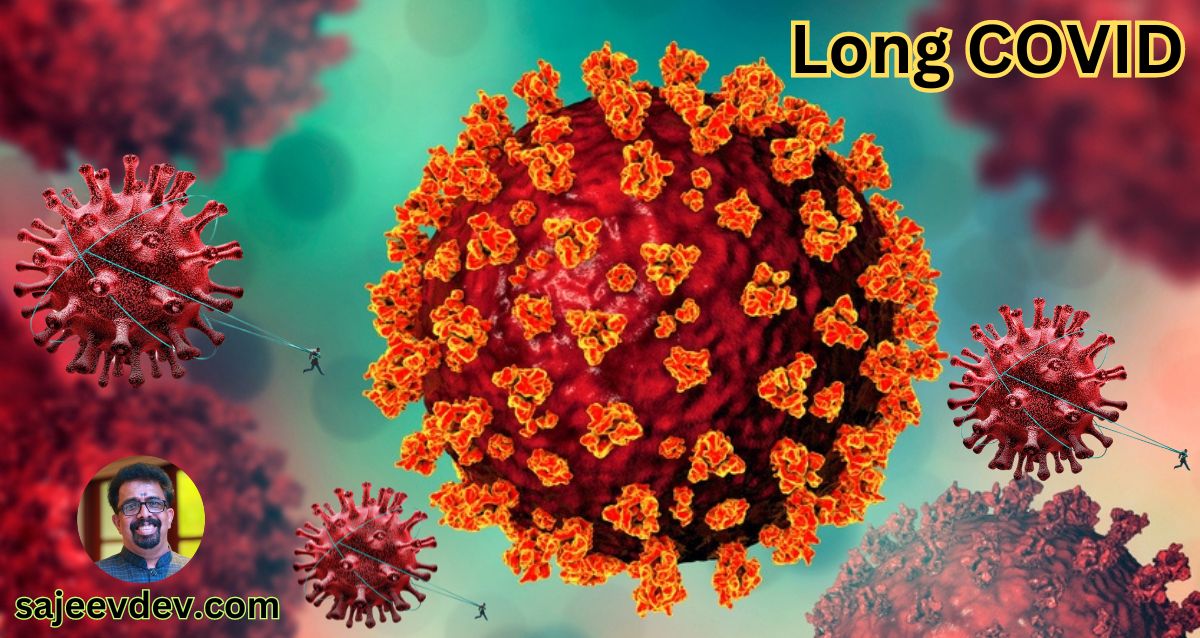Long COVID, also known as post-acute sequelae of SARS-CoV-2 infection (PASC), refers to a range of symptoms that continue or develop after the acute phase of a COVID-19 infection
Long COVID, also known as post-acute sequelae of SARS-CoV-2 infection (PASC), refers to a range of symptoms that continue or develop after the acute phase of a COVID-19 infection. This phenomenon has emerged as a significant health issue since the onset of the COVID-19 pandemic, affecting millions of individuals worldwide. Long COVID can manifest in various ways and may persist for weeks or even months following recovery from the initial viral infection.
Research indicates that a substantial proportion of individuals who have recovered from acute COVID-19 experience lingering effects. While exact figures may vary depending on the cohort studied and the methodologies employed, some estimates suggest that nearly 10-30% of those infected with the virus experience symptoms consistent with Long COVID. This condition poses serious implications for public health due to its impact on patient quality of life and healthcare systems.
The symptoms of Long COVID can range from respiratory issues, fatigue, cognitive dysfunction (often referred to as “brain fog”), to psychological effects such as anxiety and depression. These varied manifestations complicate the clinical picture and necessitate an individualized approach to diagnosis and management. The complexity of Long COVID also highlights the importance of ongoing research dedicated to understanding its underlying mechanisms and potential treatment pathways.
The emergence of Long COVID has underscored the necessity for a global health response that takes into account not only the immediate effects of COVID-19 but also its long-lasting consequences. As lingering symptoms affect daily life for those who have experienced the virus, it becomes imperative to address this condition in discussions surrounding post-pandemic recovery and healthcare planning. Understanding Long COVID is essential for fostering informed discussions, promoting awareness, and guiding the implementation of effective treatment strategies to support affected individuals.
Common Symptoms of Long COVID
Long COVID, also referred to as post-acute sequelae of SARS-CoV-2 infection (PASC), encompasses a myriad of symptoms that can persist even after the initial infection has resolved. These symptoms can significantly affect multiple systems in the body and can differ widely from person to person. The manifestations of Long COVID can broadly be categorized into three primary categories: physical, cognitive, and emotional or psychological effects.
Physical symptoms are among the most frequently reported occurrences in individuals with Long COVID. Chronic fatigue is one of the most debilitating symptoms, causing persistent tiredness that can interfere with daily activities. Patients may also experience shortness of breath, which can occur even with minimal exertion, as well as joint and muscle pain. Other physical symptoms may include headaches, palpitations, and gastrointestinal issues like nausea. These symptoms can last for weeks or even months after the acute phase of COVID-19 has subsided.
Cognitive effects, often colloquially referred to as “brain fog,” are another significant concern for those experiencing Long COVID. Individuals may report difficulty concentrating, memory lapses, and a general sense of confusion or disorientation. These cognitive challenges can hinder one’s ability to perform tasks that were once easily manageable and may have significant implications, especially in professional settings.
Emotional and psychological symptoms should not be overlooked in the discussion of Long COVID. There is a notable incidence of anxiety and depression reported among those affected. The stress of dealing with ongoing health complications, coupled with the societal changes brought about by the pandemic, can exacerbate these feelings. Thus, recognizing the varied manifestations of Long COVID is crucial for proper management and treatment options going forward.
Understanding the Mechanisms Behind Long COVID
Long COVID, also referred to as post-acute sequelae of SARS-CoV-2 infection (PASC), presents a diverse array of symptoms that can persist for weeks or even months following the acute phase of COVID-19. This prolonged condition is believed to be influenced by several underlying mechanisms. One prominent factor is the dysregulation of the immune response, which can continue to function abnormally even after the initial viral infection has resolved. In some individuals, the immune system may create a hyper-inflammatory state, leading to ongoing symptoms such as fatigue, brain fog, and other systemic issues.
Another critical component of Long COVID involves the presence of persistent viral particles within the body. Research indicates that remnants of the SARS-CoV-2 virus may linger in certain tissues, thereby maintaining an ongoing immune response. This phenomenon complicates the recovery process, as the body’s immune system remains activated against these viral particles, leading to prolonged symptoms and complications. These viral reservoirs may explain why some patients experience recurring episodes or exacerbation of symptoms.
Moreover, COVID-19 can have lasting effects on various organ systems, including the respiratory, cardiovascular, and nervous systems. This broad impact necessitates a comprehensive understanding of how the infection disrupts normal physiological functions and may lead to long-term health issues in some patients. Recent studies have shown that mechanisms such as endothelial dysfunction, inflammation, and dysregulation of the autonomic nervous system can contribute to the multifaceted symptoms associated with Long COVID. As ongoing research investigates these mechanisms, it will provide invaluable insights into why certain individuals develop Long COVID while others recover fully, ultimately guiding effective treatment strategies.
Challenges in Diagnosing Long COVID
The diagnostic landscape of Long COVID presents considerable challenges that complicate the identification and management of this condition. One primary obstacle is the absence of standardized diagnostic criteria. Unlike many traditional illnesses that have clear diagnostic frameworks, Long COVID encompasses a broad spectrum of symptoms that often vary significantly among patients. This lack of uniformity can lead to difficulties in both diagnosis and treatment, as healthcare providers are left to navigate a diverse array of manifestations without concrete guidelines.
This variability extends beyond mere symptomatology; it also includes the duration and severity of symptoms. Commonly reported issues include fatigue, cognitive dysfunction, and respiratory complications, yet some patients may experience gastrointestinal disturbances or psychological symptoms. Such a wide-ranging profile contributes to a fragmented understanding of the condition, often resulting in misdiagnosis or delayed diagnosis. Indeed, many individuals seeking care may find their symptoms dismissed or attributed to other causes, causing frustration and anxiety regarding their health status.
Healthcare providers may also be hindered by misconceptions surrounding Long COVID. Some practitioners may either underestimate the condition’s significance or lack familiarity with its long-term implications, which can lead to inadequate support for patients. This gap in knowledge underscores the necessity for enhanced education and awareness among healthcare professionals regarding the nuances of Long COVID. Establishing consistent diagnostic protocols, fostering interdisciplinary collaboration, and promoting ongoing research are imperative for improving diagnosis and ensuring that individuals affected can receive timely and appropriate care.
Recovery from Long COVID: What to Expect
The recovery journey for individuals suffering from Long COVID can vary significantly between patients, influenced by a multitude of factors including pre-existing health conditions, age, and the severity of the initial COVID-19 infection. For some, the path to recovery is straightforward, while others may experience an extended timeline with fluctuating symptoms. It is not uncommon for individuals to undergo a relapsing-remitting pattern, where symptoms improve only to re-emerge at a later stage, complicating the overall recovery process.
During recovery, patients may encounter a diverse range of symptoms that can affect physical, cognitive, and emotional well-being. Commonly reported symptoms include fatigue, muscle weakness, brain fog, and anxiety, among others. These symptoms can fluctuate in intensity, leading to periods of relative stability followed by exacerbations. As such, individuals recovering from Long COVID should prepare for an unpredictable journey and adopt a flexible approach to their recovery strategy.
Self-care emerges as a critical component during the recovery phase, emphasizing the need for patients to engage in activities that promote overall well-being. This may include adopting a balanced diet, incorporating gentle exercise, and prioritizing adequate rest. Additionally, a support system comprising healthcare professionals, family, and friends plays a vital role in facilitating recovery. Connecting with fellow Long COVID survivors through support groups can provide invaluable shared experiences, fostering a sense of community and understanding.
It is essential for those recovering from Long COVID to consult medical professionals regularly to manage symptoms effectively and track progress. Personalized rehabilitation programs and therapies tailored to individual needs can significantly enhance recovery outcomes. By understanding the nature of Long COVID and implementing supportive measures, patients can navigate their recovery journey with greater confidence and resilience.
Current Treatment Options for Long COVID
Long COVID, emerging as a complex post-viral condition, presents an array of symptoms that can vary significantly among individuals. As the medical community continues to grapple with this multifaceted syndrome, various treatment options have been explored to help manage symptoms and support recovery. Conventional therapies often focus on alleviating specific symptoms, while alternative therapies provide additional routes for managing the condition.
Rehabilitation programs, particularly those designed for pulmonary and physical rehabilitation, have gained traction. These programs aim to gradually restore physical function and endurance in patients experiencing fatigue and breathlessness, common in Long COVID. Tailored exercise regimens and breathing exercises can enhance cardiovascular health and pulmonary capacity, aiding recovery from the lingering effects of the virus.
In terms of medication, clinicians may prescribe anti-inflammatory drugs, pain relievers, or antidepressants to address the diverse constellation of symptoms associated with Long COVID. For individuals experiencing post-viral fatigue, stimulants or cognitive enhancers may be considered, albeit with careful monitoring to prevent potential side effects. The ongoing assessment of these medications’ effectiveness continues to shape the clinical management of Long COVID, as healthcare professionals seek optimal protocols for patient care.
Moreover, the research landscape is evolving with a number of promising clinical trials aimed at investigating new therapies. These include antiviral drugs to target residual viral loads and immune-modulating treatments to address persistent inflammatory responses. The results of these studies are anticipated to shed light on more definitive treatment pathways. Meanwhile, lifestyle modifications, encompassing nutrition, hydration, and stress-management techniques, can also play pivotal roles in symptom management and overall well-being.
As research continues to uncover the complexities of Long COVID, a multidisciplinary approach that combines conventional and alternative strategies appears to offer the most comprehensive support for affected individuals.
The Role of Support Networks and Resources
Support networks play a crucial role in the recovery journey for individuals suffering from Long COVID. As this condition can result in a variety of debilitating symptoms, the emotional and psychological toll may be significant. Connecting with others who share similar experiences can provide an invaluable outlet. Support groups offer a platform where individuals can share their challenges, strategies for coping, and insights into managing symptoms. Moreover, these groups can foster a sense of belonging, which is often essential for mental well-being during recovery.
Healthcare professionals specializing in post-viral syndromes are also an integral part of recovery. Their expertise often provides a better understanding of Long COVID and the myriad symptoms associated with it. By maintaining regular consultations with these professionals, individuals can stay updated on the latest treatment options and research findings, ensuring they receive evidence-based care. Furthermore, healthcare specialists can guide patients towards suitable resources and facilitate connections with other patients facing similar challenges.
In the digital age, access to online forums and educational materials extends the reach of support networks beyond geographical boundaries. Numerous websites and social media platforms host discussions and share experiences related to Long COVID. These resources often include blogs, articles, and videos that can educate patients and their families about the condition. Engaging with these materials can empower individuals with knowledge, reducing feelings of isolation and confusion that often accompany chronic health issues. Additionally, such interactions may also lead to finding local resources or support groups.
In summary, the importance of support networks and resources for those experiencing Long COVID cannot be overstated. They provide a multifaceted approach to recovery by addressing both the physical and emotional needs of individuals, ultimately enhancing their quality of life and recovery outcomes.
Personal Stories and Testimonials
The phenomenon of Long COVID has profoundly affected countless individuals around the globe, with personal stories highlighting the diverse symptoms and recovery journeys experienced by patients. For many, the aftermath of COVID-19 extends beyond the initial illness, manifesting in a range of persistent symptoms that disrupt daily life. One such story comes from Sarah, a 34-year-old educator who contracted COVID-19 early in the pandemic. After her initial recovery, she began to experience debilitating fatigue, brain fog, and an array of other symptoms that severely impacted her ability to work and enjoy time with her family. Sarah’s account sheds light on the emotional and physical toll Long COVID can exert on individuals; her struggle to regain a sense of normalcy resonates with many who face similar challenges.
Another poignant narrative is provided by Michael, a 50-year-old former athlete who enjoyed an active lifestyle prior to his COVID-19 diagnosis. Following recovery, he found himself grappling with shortness of breath and persistent joint pain that hindered his ability to exercise—a passion that was integral to his identity. Michael’s journey illustrates not only the physical symptoms associated with Long COVID but also the psychological ramifications of facing a new reality that alters personal interests and aspirations. His adaptability and determination in seeking treatment options serve as a testament to resilience in the face of adversity.
These testimonials underscore the critical need for awareness around Long COVID. Each story emphasizes the importance of understanding, supporting, and providing resources for those affected. Furthermore, sharing such experiences fosters a compassionate community that recognizes the validity of these struggles, ultimately aiding in the collective effort to address this complex and evolving health challenge.
As the global community continues to grapple with the ongoing repercussions of the COVID-19 pandemic, the phenomenon of Long COVID has emerged as a significant public health challenge
As the global community continues to grapple with the ongoing repercussions of the COVID-19 pandemic, the phenomenon of Long COVID has emerged as a significant public health challenge. The necessity for continued research into the long-term effects of the virus is paramount, especially as more individuals report lingering symptoms that affect their quality of life. Ongoing studies are crucial in uncovering the multifaceted nature of Long COVID, including its various symptoms, duration, and impact on different demographics. Understanding these aspects can help pave the way for targeted treatments and management strategies.
Furthermore, there is an urgent need for increased funding to support research initiatives aimed at investigating Long COVID. Enhanced financial resources will enable researchers to conduct comprehensive studies that can elucidate the underlying mechanisms of this condition. By investigating the biological, psychological, and social dimensions of Long COVID, researchers can contribute to an evidence-based approach that informs public health policies and practices. This could ultimately lead to the development of guidelines for healthcare providers that are essential for effective patient care.
Public health initiatives must also adapt to the realities of Long COVID. Awareness campaigns are necessary to educate both healthcare professionals and the general public about the potential long-term consequences of COVID-19. Effective communication can foster early recognition of symptoms and improve access to care, ensuring that affected individuals receive appropriate support. Additionally, lessons learned from the study of Long COVID could inform policies aimed at managing future viral pandemics, equipping health systems with the knowledge needed to mitigate similar public health threats. By fostering a thorough understanding of Long COVID, stakeholders can better prepare to address both current and future challenges posed by viral infections.



